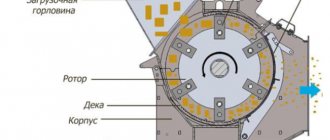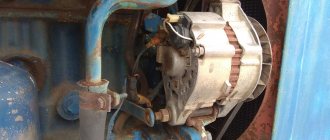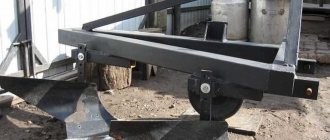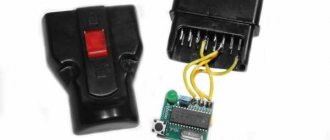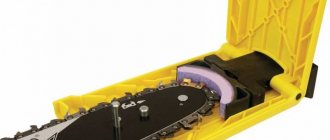What types of electric mills are there?
There are three types of home grain crushers. All of them are designed for specific types of grains and differ in power and purpose.
Electric spice grinders
The most common type of home grain grinder is spice grinders, which come in manual and electric varieties. The latter are more popular due to automatic grinding; you don’t need to put in much effort; you press a button and quickly pepper and salt the dish you’re preparing. The device looks like a hand-held tube, at the bottom of which the mills themselves are located along with a reservoir for grains and seeds, and on top there is a built-in electric motor.
Grain grinders for spices are designed exclusively for spices; you can grind something else, but it’s completely pointless.
Electric coffee grinders
Probably the most commonplace household appliance that is in every home. Usually, it is used to grind coffee, but often they crush any products available for this: peppercorns, sugar and even grain. The device looks like a stationary cylinder 20-25 centimeters high, at the top of which there is a reservoir with mills, tightly closed with a lid.
With a coffee grinder you can grind absolutely any initial product in the form of grains into flour, but there is one thing. The grinding bowl here is small, enough for a few cups of coffee or a small jar of spices, so it is not suitable for processing large volumes.
Home electric flour grinders
Designed exclusively for grinding cereal grains and producing homemade flour of selected quality (directly depends on the quality of the grain itself). A powerful device equipped with stone millstones that can handle any grain product of any hardness.
But the main feature of home flour mills is the ability to process 1 kilogram or more of grain at a time. Or get up to 10 kilograms of flour in half an hour without the risk of critical overheating of the device. Such home grain crushers are expensive and are intended for true connoisseurs of the independent process of flour production and subsequent baking of homemade bread.
Choosing an electric spice mill
It has been known since ancient times that freshly ground spices give dishes an incredible aroma and taste. Pepper, coriander, cloves and other spices can be ground at home using modern devices: the industry produces special household manual and electric grinders. Electric models can be powered by mains power, rechargeable batteries, or regular replaceable batteries. Battery or battery-powered spice grinders are suitable not only for home kitchens: they can be used in country and camping conditions.
To make spicy seasoning using an electric device, no effort is required, unlike using a manual analogue.
Electric salt and pepper mills are usually small in size. The device is a body, usually in the shape of a flask, inside of which there is a motor, millstones and a container for collecting the crushed spicy product. The ease of use of the electrical appliance and the quite affordable price for many housewives became the determining factors for purchasing such an assistant, because ground spices from store-bought bags are significantly inferior in aroma and taste to freshly ground ones.
When choosing a device, you should pay attention to the case materials. According to user reviews, the best option for grinding seasonings is a stainless steel mill. The material is durable, odor-neutral and gives the product a presentable appearance. An important element in the device is the millstone. To grind spices, knives made of high-strength plastic, stainless steel and ceramics are used. Plastic knives can be found in budget models. They are short-lived - service life is about 5 years. Therefore, from the point of view of operation, it is preferable to choose a device with knives made of stainless steel or ceramics. But the price of such devices will be higher. Prices for spice grinders vary from 700 to 6000-7000 rubles.
It is up to the buyer to decide which electric mill to choose for their home, focusing on functionality, performance and price tag.
How to choose a home mill?
All three options for grain crushers for home are easy to choose due to the simplicity of the design: the electric motor itself, the millstones and the grain tank. But for each case there are some nuances:
- Choosing a spice grinder. The power of the electric motor and the efficiency of the millstone system should be taken into account; it is best to personally check how the grinder works; without checking, you may remain dissatisfied. Don’t buy a cheap mill, it won’t last long, it’s better to pay extra and buy a high-quality device that can handle any spice grains and will work without interruption, otherwise it’s better to buy a manual version. Rechargeable batteries are preferable to AAA batteries.
- Choosing a coffee grinder. If you are going to grind coffee a lot and often, then look for models with good power and an increased volume of the bean tank. And if not, then a standard cheap coffee grinder of low power for a couple of cups of drink or a little powdered sugar will become a completely normal purchase. It is better to purchase branded European equipment of high quality.
- Choosing a household electric mill. It’s hard to make a mistake in this case, because not everyone can buy a grain mill. The device, which processes up to 1 kilogram of grains at a time, is sold at a price of no less than 25,000 rubles. Here, in fact, very good power and reliable stone millstones are implemented, which are durable and grind any grains efficiently.
Rules of operation and care
Knowledge of the rules of proper operation and high-quality care of hand mills will increase their service life and guarantee the safe composition of the resulting product. The main points include:
- monitoring the integrity of the hull and timely elimination of external damage;
- careful adherence to sanitary and hygienic treatment and disinfection regimes (if necessary);
- strong fastening of the mill to the base at the time of use (to prevent distortion of the structures);
- regular cleaning of millstones and storage containers from residual raw materials and flour;
- degreasing and drying all components of mechanisms;
- proper lubrication of rubbing parts (if any) with gentle compounds approved for food use;
- compliance with basic safety rules when working with rotating mechanisms.
The use of hand-ground products in cooking is a confirmation of the housewife’s love and care for her household, her desire to make the diet tasty, healthy, nutritious and safe.
The best household electric mills
For spices
Fissman 8211
A relatively inexpensive spice mill, which can be purchased for no more than 1000 rubles. Fissman is a European manufacturer from Denmark, which is well known among us. A special feature of the model is the ability to choose from different colors: pink, yellow, blue, white. The millstones are made of ceramic and have built-in lighting. When you add salt or pepper, you will see exactly how much spice you have added. Battery operated.
Bisetti Electric 962
Italian company producing kitchen utensils. The model is standard, but made with high quality, acrylic and metal are used. The electric motor is powered by 6 AAA batteries. In terms of price/quality, this is one of the most affordable mills, which can be purchased for 2,500 rubles.
Tescoma President 2 in 1
An interesting combined electric mill for two types of spices at once. Half the tank can be filled with pepper and the other half with salt. Tescoma is a well-known Czech manufacturer of kitchenware and accessories, which makes its products with high quality and a guarantee. The device is made of metal/plastic and is powered by 6 AAA batteries and has a reliable motor. Price – 3000 rubles.
Cole & Mason Chiswick
An excellent set of two grain crushers from a British manufacturer, which can be purchased for 6,000 rubles. The devices run on four AAA batteries each. Electric mills are made entirely of high quality steel. Just press a button and get great results. The power is enough to grind relatively large volumes of spices without critical overheating.
Peugeot Elis with charger
A French corporation that produces not only famous cars, but also kitchen utensils such as electric spice grinders. This model will cost a lot of money - 8,000 rubles, but the device fully justifies its cost with high quality workmanship and a built-in battery with its own charger. This electric grain crusher is made of high-quality metal, has 6 grinding levels and a reliable mill mechanism, which is covered by a 50-year warranty.
For coffee
Bosch TSM6A01
German quality, inexpensive price, nice classic appearance, and these are not all the advantages of this model. At a cost of 1,500 rubles, the electric coffee grinder has a good capacity and can grind up to 75 grams of coffee or other beans at once. Power – 180 watts. The device is simple but practical.
DeLonghi KG 49
One of the most popular coffee grinders from this manufacturer. It has a good grain capacity of up to 90 grams and a good power of 170 watts. A special feature of the model is the presence of a timer and a dispenser design. It is also convenient to wind the cord and there is a power lock when the cover is removed. At a price of 2,700 rubles, it is a very worthy model.
REDMOND RCG-M1607
A new product from the company, with a volume of up to 90 grams of grains, high power of 200 watts and protection against overheating. At the same time, the coffee grinder looks stylish and is made of high-quality metal and plastic. There is also a lock when the lid is open and convenient winding of the power cord.
For grain
Komo Fidibus 21
A home electric mill, which you can buy for 29,000 rubles, which is not cheap, but the device is exclusively for those who appreciate self-grinding flour from any grain. The model allows you to load 850 grams of wheat at once and get up to 250 grams of flour per minute (8 kilograms of flour in half an hour). Motor power – 250 watts. The millstones are made of ceramics and corundum, which are highly durable and allow you to obtain excellent results. You can also adjust the degree (fraction) of grinding.
Hawos Easy
A similar priced flour grinder can be purchased for the same price – 29,000 rubles. Millstones made of ceramics and corundum are also used here, and the productivity is 250 grams of flour per minute. The volume of the bowl for loading grain is slightly smaller - 560 grams. You can grind up to 8 kilograms of flour at a time. Electric motor power 360 watts.
Housing material
The best material for the body of a hand mill is wood. The most popular raw materials for these purposes today are beech, pine, and linden. The production of such household kitchen appliances is carried out by both famous manufacturers (for example, German companies) and folk craftsmen. Professional products have a longer service life, since the raw materials undergo additional processing with special compounds, wax, and natural oils. A hand-held grain mill may have a cedar or other sturdy wood finish.
The use of wooden materials determines not only environmental friendliness, practicality and the necessary hygienic characteristics of the product, but also the fight against noise. If the model is manufactured correctly, the noise level during operation should not exceed 72 dB.
Cheaper options are mills made of veneer, plastic, glass, and ceramics. However, such materials have insufficient resistance to mechanical damage, are unreliable and therefore have a short service life. In addition, low-grade plastic is able to absorb odors and retain them for a long time.
There are also metal models that are resistant to mechanical stress and, due to their significant weight, physically facilitate the grinding process. However, such material is not an environmentally friendly raw material.
Wooden
Plastic
Glass
Metal
Device Features
The grain crusher cannot be called special, but different models have enough features. True, they usually concern small and insignificant details, which do not greatly affect its performance, but they definitely make the device more convenient - it becomes much easier to use.
Accordingly, the work goes faster, the grinding becomes better, and the saved time and effort can be spent on any other useful things that can always be found on a farm where the use of a crusher is necessary.
Grain crusher
Any grain crusher, be it Bumblebee, Bison, Piggy, Cyclone, or Spike, is similar in principle to a coffee grinder, only with the exception that grain crushers are much more powerful.
- Whole grain is poured into a special compartment called a “hopper”.
- Passing through the department with knife-hammers, it is crushed to the required fraction.
- Depending on what exactly needs to be obtained at the output, different hammers are used, because in a grain crusher you can grind just grain, or whole ears, along with the stems on which it grew.
For more information about the operation of the grain crusher, watch the video:
This applies to both wheat and other grain crops, including barley, corn and buckwheat. Thanks to this, you can prepare a variety of food for all poultry and animals. Also, grain crushers can grind oily products, such as sunflower meal.
It is fundamentally different from dry grain because it has much greater viscosity and when crushed, the resulting grain is much larger. Just as in the case of grains and oilseed crops, a grain crusher can grind root vegetables, whole ears of corn, hay and grass.
But given that this is not the direct purpose of the inventory, such actions are the exception rather than the rule. In order to please livestock with a salad of fresh vegetables garnished with hay, it is better to use a feed chopper.
Also, regarding working with a household grain crusher, there are some rules for farms and households that must be followed at all times and special attention must be paid to them.
Since the operation of the device is based on knives - hammers, which carry out chopping thanks to centrifugal force, it is worth pouring the grain evenly and in small portions. In large quantities, it can jam the mechanism, which will lead to instant damage to the engine or shaft.
This problem can be solved with the help of a feed valve, which, although installed in many models, is still missing in some.
Never, under any circumstances, should you leave a crusher connected to the mains unattended, especially if there are children nearby.
Moreover, children should not be allowed to work with it without supervision - the grain crusher has a lot of open moving parts. Also, it is highly undesirable to start a grain crusher that is already preloaded - in most cases the engine will not be able to start.
In general, in terms of engine load, grain crusher, feed cutter, grass cutter, and household feed choppers are very demanding. When the device is turned on, it must be under a payload at all times - idle operation does not benefit it. It should only last a few seconds.
The duration of continuous operation is also limited . In order not to overload the device, it must be turned off approximately every hour - the hammers and the motor must cool down at this time. If you follow these simple but very important rules, your equipment will last a very long time.
Morphemic analysis
In the process of parsing a word, a kind of analysis of morphemes and its components is carried out. At the final stage, the student can much better understand the structure of the example and related words, as well as analyze as much as possible and learn to independently use in practice the mechanisms of word formation in the Russian language. Morpheme is the minimum indivisible significant part of a word that is needed to form new forms.
Some textbooks describe in detail information about morphemic parsing and word analysis as identical parameters. But in practice everything is a little different. During these two analyses, a number of significant differences can be noted. For morphemic analysis, the word is used without any changes, but for analysis by composition, the initial form is required. During word-formation analysis, it is necessary to indicate whether the expression involved is derivative or not.
The morphemic analysis of the word grinding is distinguished by its simplicity: root (mel) + suffix (yush) + ending (ii). The basis is grinding. Method of word formation: suffixal. There is a certain order of morphemic analysis, which is better not to change even if you want to perform a more simplified analysis. It is necessary to follow the instructions, as in this case you will be able to avoid mistakes.
You need to understand that a word cannot have more than one prefix and suffix. To be able to distinguish between these concepts, you need to try to find the closest predecessor of this word in the word-formation chain. To find the ending you need to change the example. The student may encounter a situation where this parameter is null. Suffixes are located after the root and they serve to form new expressions. Finding this component of morphemic analysis is quite simple. A suffix is the part of a word that is located between the root and the ending.
Universal and multifaceted morphemics deals with the analysis of words in parts. In various dictations, exams and presentations you can often find a task that concerns the analysis of the word being studied. If the example is changeable, the inflection or ending is set. Otherwise, it will not be possible to perform a qualitative analysis.
Synonyms: quick reference
dictionary entries found: 1
babble (simple) babble (simple) chatter rave (simple) lie blurt out fence (colloquial) flood (simple) lie pour bullets grind (colloquial) carry (colloquial) deceive weave (colloquial) flog (colloquial) .) idle talk idle talk idle talk babble compose (colloquial) gibberish gibberish (simple) poison (simple) chatter (colloquial) chatter (colloquial)
2. In which word is the letter I written? a) they are ripping out the seams b) the parents are busy c) they are idle d) the children are building a house out of sand
- Ask for more explanation
- Track
- Flag violation
What do you want to know?
From the history of the issue
Coffee as a drink would have been banned in many countries for a long time. At the beginning of the 17th century it penetrated into Europe. But before that, its properties were discovered in Muslim countries. The drink, which gave vigor and strength to a tired body, became very popular. Coffee shops were opened, where people sat for many hours, sipping coffee, talking, and relaxing. After a while, they began to miss prayer meetings. Therefore, the drink was prohibited. It was only two centuries later that coffee returned to the Arab world.
In the 18th century, the drink conquered America. It was here that they began to grind it and serve it in powder form. In Russia, they learned about coffee in 1665, during the reign of Peter I’s father. Alexei Mikhailovich was offered a new medicine for “runny nose, headaches and arrogance.” This is how the drink came to Russia. Peter Alekseevich, Catherine II, and Anna Ioanovna really liked the invigorating drink.
Old Believers considered the coffee drink a “satanic drink.”


